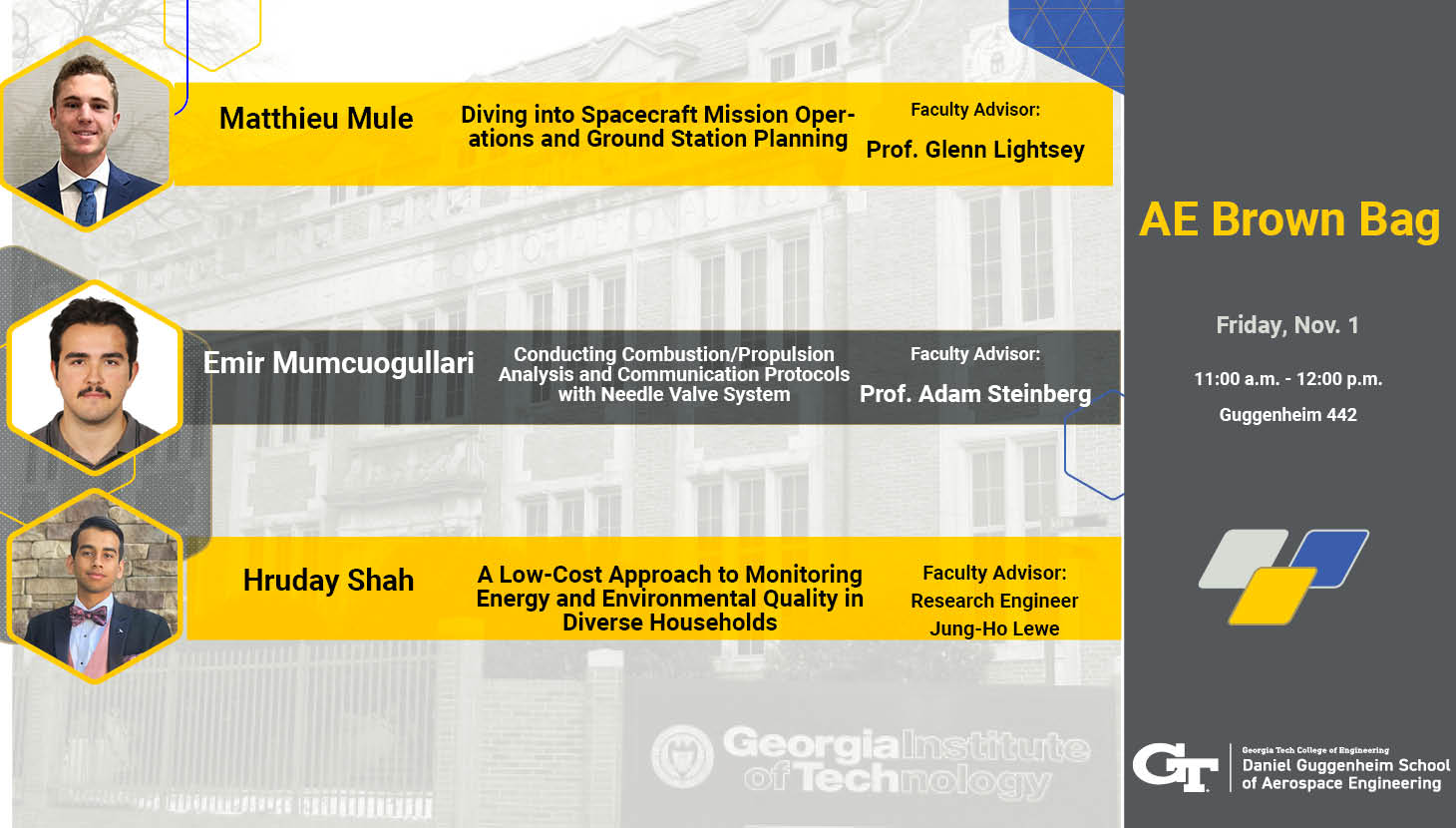
AE Brown Bag Seminar
Friday, November 1
11:00 a.m. -12:00 p.m.
Guggenheim 442
Pizza Served
Matthieu Mule
Emir Mumcuogullari
Hruday Shah
Matthieu Mule
Title:
Diving into Spacecraft Mission Operations and Ground Station Planning
Abstract:
CubeSats are, as the name indicates, small-sized satellites that are cheaper, more
efficient, and lighter than the full-sized satellites aerospace companies send into space. They
can be sent to low-Earth Orbit (LEO), or further on Sun-synchronous orbits. These satellites are
perfect for university projects like the ones I have worked on in Space Systems’ Design Lab
(SSDL): Lunar Flashlight and VISORS. The goal of this presentation is to explore and
understand how Mission Operations and Ground Station plans are developed for the launch
readiness of CubeSats like the two VISORS satellites. With the help of my team members and
ground station operators, I have written multiple critical operations procedures and learned
ground station knowledge that will help set the spacecrafts up for their mission in space. By
analyzing numerous documents, asking questions to my peers, and troubleshooting each
system, I have learned to ask the right questions to build detailed procedures for our team. I
have interfaced with the Ground Stations understanding how their system works and what they
need for launch readiness. The deliverables made are a basic pass procedure, a command
sequence verification and validation procedure, and a data processing script for the data flow
prototype. In a Mission Operations procedure, the goal is to foolproof it as if a middle-schooler
could follow the instructions and operate the spacecraft. The procedures that our team is writing
are incredibly detailed and cover every scenario that could happen to the spacecraft. This is one
of the reasons why I enjoy Mission Operations and why I believe it trains aerospace engineers
to be flawless Systems engineers. Mission Operations teaches you to think outside the box, and
think of every possible step in a process. Systems Engineering helps you combine the systems
to make a spacecraft that can functionally escape unfavorable situations with the help of
Mission Operators.
Faculty Advisor:
Professor Glenn Lightsey
Emir Mumcuogullari
Title:
Conducting Combustion/Propulsion Analysis and Communication Protocols with Needle Valve System
Abstract:
This presentation outlines experience in advanced propulsion systems modeling and simulation, beginning with contributions to the Artemis I Gateway's propulsion subsystem modeling using model-based systems engineering (MBSE). Professional experience includes serving as a Teaching Assistant for MBSE instruction, utilizing MagicDraw to train industry engineers. The work encompasses computational fluid dynamics (CFD) analysis through ANSYS, focusing on aerodynamic behavior and supersonic nozzle flow simulation across various configurations. Research efforts extended to combustion analysis, specifically examining detonation wave characteristics and survival properties in linear rotating detonation engines (LRDE). Additional research involved simulation and modeling of magnetoplasmadynamic thrusters (MPDT) for scaling applications. Current research focuses on needle valve system protocol development in the BTZ Combustion Laboratory, aimed at achieving precise fuel inflow control in supersonic swirl flow conditions to optimize flame stability characteristics.
Faculty Advisor:
Prof. Adam Steinberg
Hruday Shah
Title:
A Low-Cost Approach to Monitoring Energy and Environmental Quality in Diverse Households
Abstract:
According to a 2018 publication by the U.S. Department of Energy, “low-income households spend a larger portion of their income on home energy costs…than other households spend” [1]. Energy inequality, or the disparity in energy access, usage, and efficiency across socioeconomic groups, is a growing concern in the Southeastern United States, particularly in urban areas like Atlanta. This project aims to quantify energy inequality by deploying a network of low-cost "hub and spoke" Internet-of-Things (IoT) sensors in a representative sample of lower-income and affluent households.
The indoor air quality (IAQ) sensor monitors traditional environmental parameters, such as temperature, relative humidity, particulate matter (PM) concentration, and CO2 concentration, as well as other parameters, such as pressure, noise, and light levels. The IAQ sensor provides insight into the quality-of-life parameters as well as how efficiently the ventilation, filtration, and insulation systems work. Another sensor being developed is a current transformer (CT) sensor which is used to measure the current supplied to certain devices/parts of a home. With the knowledge of voltage distribution across the home, the energy consumption can be calculated allowing for cost estimations.
By monitoring and analyzing data on energy consumption patterns, our team seeks to illuminate the technological and socioeconomic factors contributing to energy disparities. To ensure manufacturability and scalability, the project collaborates with K-12 students at the Johnson STEM Activity Center (JSAC), producing kits and easy-to-assemble devices. This approach not only enables the production and deployment of cost-effective sensors but also introduces students to STEM, fostering skills in technology and data analysis.
[1] Low-Income Household Energy Burden Varies among States, www.energy.gov/sites/prod/files/2019/01/f58/WIP-Energy-Burden_final.pdf. Accessed 25 Oct. 2024.
Faculty Advisor:
Research Engineer Jung-Ho Lewe